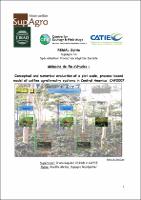| dc.contributor.advisor | Metay, Aurélie | |
| dc.contributor.author | Remal, Sylvie | |
| dc.contributor.author | CATIE – Centro Agronómico Tropical de Investigación y Enseñanza, Turrialba, Costa Rica. CIRAD. | |
| dc.date.accessioned | 2022-03-01T20:41:49Z | |
| dc.date.available | 2022-03-01T20:41:49Z | |
| dc.date.issued | 2010 | |
| dc.identifier.uri | https://repositorio.catie.ac.cr/handle/11554/11668 | |
| dc.description | 40 páginas : Contiene 11 ilustraciones y 9 tablas. | es_ES |
| dc.description | Tesis (Mag.Sc.) – CATIE | |
| dc.description | Bibliografía páginas 38-40 | |
| dc.description.abstract | The objectives of the present study are (i) to do a conceptual evaluation of the CAF2007 model by identifying the main biophysical processes which need to be well simulated, and (ii) to evaluate its capacity to simulate coffee agroforestry systems’ productivity by confronting simulations using data from two long-term experiments in Central America. We first performed a conceptual evaluation of CAF2007, which means that it has been tested for its capacity to well describe the main biophysical processes involved in coffee agroforestry systems. This step was important to test if the model can be used to simulate effects of coffee agroforestry systems’ management on their productivity but also on social and environmental services. By doing that, we could highlight some critical points and particularities of the model that could be further improved, focusing on coffee productivity. As a result of the conceptual evaluation, four biophysical processes were identified important to be correctly simulated by the model; (i) the effect of shading on reproductive dynamics, (ii) the coffee carbon production and organs allocation, (iii) nitrogen dynamics and (iv) water dynamics. Data have already been collected from both sites to perform automatic calibration through Bayesian method to quantify the model uncertainties (van Oijen et al., submitted). Parameters to include for this calibration can be selected according to three criteria: (i) from the literature review, (ii) the conceptual evaluation to select parameters which are involved in the four identified processes and (iii), from the sensitivity analysis which permits to screen important parameters from all the parameters set. | es_ES |
| dc.format.extent | 40 páginas | es_ES |
| dc.language.iso | en | es_ES |
| dc.publisher | CATIE | es_ES |
| dc.subject | COFFEA ARABICA | es_ES |
| dc.subject | PARCELAS | es_ES |
| dc.subject | MODELOS | es_ES |
| dc.subject | PROCESOS | es_ES |
| dc.subject | FACTORES AMBIENTALES | es_ES |
| dc.subject | RENDIMIENTO DE CULTIVOS | es_ES |
| dc.subject | CALIDAD DEL PRODUCTO | es_ES |
| dc.subject | PRODUCTIVIDAD | es_ES |
| dc.subject | SERVICIOS AMBIENTALES | es_ES |
| dc.subject | BIOFISICA | es_ES |
| dc.subject | AGROFORESTERIA | es_ES |
| dc.subject | AMÉRICA CENTRAL | es_ES |
| dc.subject.other | Sede Central | es_ES |
| dc.title | Conceptual and numerical evaluation of a plot scale, process-based model of coffee agroforestry systems in Central America : CAF2007 | es_ES |
| dc.type | Tesis | es_ES |
| dc.identifier.status | openAccess | es_ES |
| dc.subject.sdg | ODS 9 - Industria, innovación e infraestructura | es_ES |


